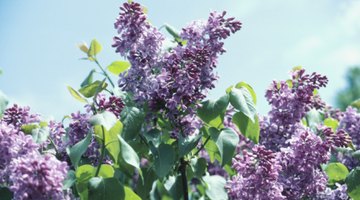Do I Need to Cover My Lilac Bushes?
Winter can harm sensitive bushes, causing myriad forms of damage, from broken branches caused by snow and ice to damaged bark caused by foraging animals.

Covering shrubs can prevent some of the major types of winter damage, and should be seriously considered by gardeners living in areas where winters are very harsh, or for plants in highly exposed areas of the garden, such as hillsides. Since lilacs are relatively sensitive plants, it's especially important to decide whether covering them is appropriate.
Factors in Deciding to Cover Lilacs
Lilacs should be covered if any of the factors leading to severe winter damage are present in a region. These factors include heavy snows that can break the shrub's branches, temperatures well below freezing for several days and harsh winds.
Factors that Make Covering Inappropriate
Covering is not appropriate in areas where winters are warm, even if there is normally some snow. Alternating periods of cold weather with rainfall or snow and warm weather foster the growth of mold. Burlap covers, the most common type of shrub covering, provide a warm place for mold to grow. Since lilacs are prone to fungal diseases such as powdery mildew infestation, encouraging mold growth can damage lilacs more in a mild winter than any snow damage.
Temporary vs. Long-Term Covering
To avoid mold growth, yet offer some protection during snowstorms, temporary wooden covers will protect smaller lilacs. These can also be left in place all winter in areas with harsh winters. For large lilacs, however, or in areas where wind is a serious problem, wooden shelters are not sufficient, and can get blown away. Long-term coverings of burlap wrap are essential under these conditions.
Removing Coverings
Lilacs should be uncovered as soon as the last danger of heavy snow is past. Leaving coverings on as the weather warms can lead to mold growth, even in cooler or drier climates.
References
Writer Bio
Christina Inge is a freelance writer, marketer and designer with more than 12 years experience in the consumer and business-to-business fields. She has a bachelor's degree in English and a master's degree in adult education and instructional technology. Her interests include technology, marketing, textiles and health.
Photo Credits
- Hemera Technologies/Photos.com/Getty Images
- Hemera Technologies/Photos.com/Getty Images
More Articles



